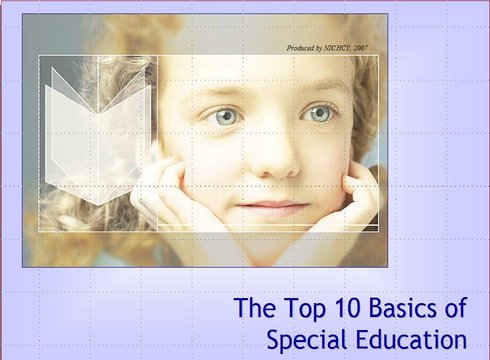 by Lisa Küpper
by Lisa Küpper
July 2007 (see Editor’s note, below)
** Este módulo está disponible en español: Los 10 Datos Principales Acerca de la Educación Especial
Editor’s note | January 2018 | This module was first produced by the National Dissemination Center for Children with Disabilities (NICHCY) in 2007. NICHCY no longer exists, and most of its materials have moved here, to the Center for Parent Information and Resources. While the date of publication for this training module was July 2007, the information provided about the 10 basics of the special education process is still accurate. The requirements of the law (IDEA) have not changed since this module was written. What’s most likely out of date as of January 2018 will be the many references to resources of further information or assistance on the steps involved in special education.
___________________
Module 1 welcomes everyone to IDEA. With these training materials, you can learn about and give trainings that include:
- a quick overview to the 10 major steps in special education (three of which are evaluation, eligibility, and writing the IEP); and
- the top 5 acronyms used in special education (IDEA, FAPE, LRE, IEP, and TA&D) and what they mean; and
- 5 key terms in IDEA and their definitions (child with a disability, special education, related services, supplementary aids and services, and transition services).
Module 1 is available in English and Spanish, as you’ll see below. It includes:
- 2 slideshow presentations;
- a Trainer’s Guide to the content of each slideshow; and
- handouts for participants.
Please help yourself ! Download the components you need to learn on your own and/or to train others in the top 10 basics of special education.
Just looking for a quick summary, not all this detail?
You’re in luck. Visit these resources on our site:
___________________________________
 Component #1: The Slideshows | Las Diapositivas
Component #1: The Slideshows | Las Diapositivas
Due to its size and complexity, Module 1 is the only module in Building the Legacy that’s divided into 2 slideshows. If you want to give an overview of the special education process and acquaint audiences with its 5 top acronyms, download Slideshow 1-1. If you want to go into a lot of detail, including the 5 key terms in IDEA, then also download Slideshow 1-2.
Slideshow Presentation in English
Saved as a Powerpoint presentation. Extract the ZIP file you want, then double-click on the PLAY.bat file to launch the slideshow.
Slideshow 1-1 (Zip folder)
Slideshow 1-2 (Zip folder)
Diapositivas en Español **
Saved as a Powerpoint Show. If you don’t have the Powerpoint software, download the free Viewer.
PDF for Trainers | This file shows trainers how the slideshows in Spanish work. (Be sure to download the trainer’s guide in English—immediately below—which explains the content of each slide.)
Component #2: Trainer’s Guide to the Content
This guide is in English but should also be downloaded if you’re training in Spanish. That’s because here is where you’ll find the full explanation of each slide’s content. It also offers much additional info so that trainers can adapt training sessions to a length or detail suitable to the given audience.
PDF | Complete guide to both slideshows (128 pages, 3.8 MB)
Word | Complete Trainer’s Guide discussion for both slideshows (Accessible Word file)
Component #3: Participant Handouts | Folletos para Participants
Theme A handouts for participants are available in English and Spanish and are designed to accompany Modules 1 and 2. For your convenience, the handouts are available in PDF and accessible Word formats.
Handouts in English
PDF | English Handouts for Theme A
Word | English Handouts for Theme A (Accessible Word file)
Folletos en Español **
Word | Los Folletos para la Tema A (en archivo accesible)
Note about the Spanish Translations:
In preparing the handouts in Spanish, we’ve chosen to use a certain vocabulary set for the terminology most frequently used in IDEA. IDEA itself is extremely and purposefully consistent about its terminology, and we felt it critical to do the same in Spanish. However, we fully recognize that there are many ways to say the same thing, and Spanish is rich with alternatives from country to country, region to region. So we’ve also prepared a glossary of the terminology used in IDEA, how we’ve rendered that terminology in Spanish, and other ways of rendering it that families may also hear. Share this with participants as you see fit or use it to guide your own translations. The glossary of terminology is available in two formats, PDF and Word:
There! You have all you need for Module 1. Please remember that these materials are designed to be thorough and authoritative sources of info on IDEA 2004. That’s why they are so detailed. As a trainer, you are free to adapt the info we’ve offered to serve the purposes and needs of your audiences and the amount of time you have to spend with them.
Back to top
 ________________________________________________________
________________________________________________________
**Highly Rated Resource! This resource was reviewed by 3-member panels of Parent Center staff working independently from one another to rate the quality, relevance, and usefulness of CPIR resources. This resource was found to be of “High Quality, High Relevance, High Usefulness” to Parent Centers.
________________________________________
Quick-Jump Menu to Other Modules
1: Top 10 Basics of Special Education (you’re already here)
2: Key Changes in IDEA
5: Disproportionality in Special Education
6: Early Intervening Services and Response to Intervention
7: Highly Qualified Teachers (withdrawn with the reauthorization of NCLB as the ESSA in 2015)
8: NIMAS
9: Introduction to Evaluation under IDEA
10: Initial Evaluation and Reevaluation
11: Identification of Children with Specific Learning Disabilities
12: The IEP Team
13: Content of the IEP
14: Meetings of the IEP Team
15: LRE Decision Making
16: Children Enrolled by Their Parents in Private Schools
17: Introduction to Procedural Safeguards
18: Options for Dispute Resolution
19: Key Issues in Discipline

